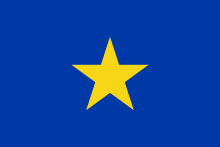Congo Free State
Coordinates: 5°51′S 13°03′E / 5.850°S 13.050°E
| Congo Free State | ||||||||||
| ||||||||||
| State in Personal union with the Kingdom of Belgium | ||||||||||
| ||||||||||
| ||||||||||
| Motto French: Travail et progrès (Work and Progress) | ||||||||||
| Anthem Vers l'avenir | ||||||||||
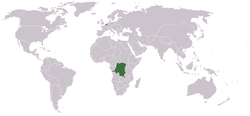 | ||||||||||
| Capital | Boma | |||||||||
| Languages | French (de facto official), more than 200 indigenous languages | |||||||||
| Government | Absolute monarchy | |||||||||
| Sovereign | ||||||||||
| • | 1885-1908 | Leopold II of Belgium | ||||||||
| Governor-general | ||||||||||
| • | 1885–1886 | Francis Walter de Winton (first) | ||||||||
| • | 1900-1908 | Théophile Wahis (last) | ||||||||
| Historical era | New Imperialism | |||||||||
| • | Established | July 1[1] 1885 | ||||||||
| • | Annexation by Belgium | November 15, 1908 | ||||||||
| Currency | Congolese franc | |||||||||
| ||||||||||
| Today part of | | |||||||||
The Congo Free State (French: État indépendant du Congo, lit. "Independent State of the Congo") was a large state in Central Africa from 1885 to 1908, which was in personal union with the Kingdom of Belgium under Leopold II. Leopold was able to procure the region by convincing the European community that he was involved in humanitarian and philanthropic work and would not tax trade.[2] Via the International Association of the Congo he was able to lay claim to most of the Congo basin. On May 29, 1885, the king named his new colony the Congo Free State. The state would eventually include an area about the size of the present Democratic Republic of the Congo.
Leopold's reign in the Congo eventually earned infamy due to the increasing mistreatment of the indigenous peoples. Leopold extracted ivory, rubber, and minerals in the upper Congo basin for sale on the world market, even though his nominal purpose in the region was to uplift the local people and develop the area. Under Leopold II's administration, the Congo Free State became one of the greatest international scandals of the early-20th century. The report of the British Consul Roger Casement led to the arrest and punishment of white officials who had been responsible for killings during a rubber-collecting expedition in 1903.
The loss of life and atrocities inspired literature such as Joseph Conrad's Heart of Darkness, and raised an international outcry. Debate has been ongoing about the number of excess deaths in this period.[3] The boldest estimate has it that the forced labour system directly and indirectly led to the deaths of 20 percent of the population.[4] During the Congo Free State propaganda war, European and US reformers exposed the atrocities in the Congo Free State to the public through the Congo Reform Association, founded by Casement and the fervent humanitarian journalist E. D. Morel. Also active in exposing the activities of the Congo Free State was the author Arthur Conan Doyle, whose book The Crime of the Congo was widely read in the early 1900s. By 1908, public pressure and diplomatic manoeuvres led to the end of Leopold II's rule and to the annexation of the Congo as a colony of Belgium, thenceforth known as the Belgian Congo. In addition, a number of major Belgian investment companies pushed the Belgian government to take over the Congo and develop the mining sector.[5]
Background
Part of a series on the |
||||||||||||||||||
|---|---|---|---|---|---|---|---|---|---|---|---|---|---|---|---|---|---|---|
| History of the Democratic Republic of the Congo | ||||||||||||||||||
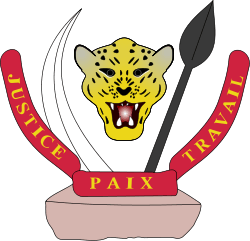 | ||||||||||||||||||
|
||||||||||||||||||
|
| ||||||||||||||||||
Early European exploration
Diogo Cão traveled around the mouth of the Congo River in 1482,[6] leading Portugal to claim the region as England did with River Victoria. Until the middle of the 19th century, the Congo was at the heart of independent Africa, as European colonialists seldom entered the interior. Along with fierce local resistance, the rainforest, swamps, and attendant malaria, and other diseases such as sleeping sickness made it a difficult environment for Europeans to settle. Western states were at first reluctant to colonize the area in the absence of obvious economic benefits.
Stanley's exploration
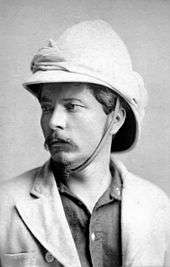
In 1876 Leopold II of Belgium hosted a geographic conference in Brussels, inviting famous explorers, philanthropists, and members of geographic societies to stir up interest in a "humanitarian" endeavor for Europeans to take in central Africa to "improve" and "civilize" the lives of the indigenous peoples. At the conference, Leopold organized the International African Association with the cooperation of European and American explorers and the support of several European governments, and was himself elected chairman. Leopold used the association to promote plans to seize independent central Africa under this philanthropic guise.
Henry Morton Stanley, famous for making contact with British missionary David Livingstone in Africa in 1871, later explored the region during a journey that ended in 1877 and was described in Stanley's 1878 novel Through the Dark Continent.[7] Failing to enlist British interest in developing the Congo region, Stanley took up service with Leopold II, who hired him to help gain a foothold in the region and annex the region for himself.[8]
From August 1879 to June 1884 Stanley was in the Congo basin, where he built a road from the lower Congo up to Stanley Pool and launched steamers on the upper river. While exploring the Congo for Leopold, Stanley set up treaties with the local chiefs and with native leaders.[8] Few to none of these tribal leaders had a realistic idea of what they were signing, and, in essence, the documents gave over all rights of their respective pieces of land to King Leopold II. With Stanley's help, Leopold was able to claim a great area along the Congo River, and military posts were established.
Christian de Bonchamps, a French explorer who served Leopold in Katanga, expressed attitudes towards such treaties shared by many Europeans, saying, "The treaties with these little African tyrants, which generally consist of four long pages of which they do not understand a word, and to which they sign a cross in order to have peace and to receive gifts, are really only serious matters for the European powers, in the event of disputes over the territories. They do not concern the black sovereign who signs them for a moment."[9]
King Leopold's campaign
Leopold began to create a plan to convince other European powers of the legitimacy of his claim to the region, all the while maintaining the guise that his work was for the benefit of the native peoples under the name of a philanthropic "association".
The king launched a publicity campaign in Britain to distract critics, drawing attention to Portugal's record of slavery, and offering to drive slave traders from the Congo basin. He also secretly told British merchant houses that if he was given formal control of the Congo for this and other humanitarian purposes, he would then give them the same most favored nation (MFN) status Portugal had offered them. At the same time, Leopold promised Bismarck he would not give any one nation special status, and that German traders would be as welcome as any other.
"I do not want to risk...losing a fine chance to secure for ourselves a slice of this magnificent African cake"
Leopold then offered France the support of the association for French ownership of the entire northern bank of the Congo, and sweetened the deal by proposing that, if his personal wealth proved insufficient to hold the entire Congo, as seemed utterly inevitable, that it should revert to France.
He also enlisted the aid of the United States, sending President Chester A. Arthur carefully edited copies of the cloth-and-trinket treaties British explorer Henry Morton Stanley claimed to have negotiated with various local authorities, and proposing that, as an entirely disinterested humanitarian body, the association would administer the Congo for the good of all, handing over power to the locals as soon as they were ready for that responsibility.
Lobbying and claiming the region
Leopold was able to attract scientific and humanitarian backing for the International African Association (French: Association internationale africaine, or AIA), which he formed during a Brussels Geographic Conference of geographic societies, explorers, and dignitaries he hosted in 1876. At the conference, Leopold proposed establishing an international benevolent committee for the propagation of civilization among the peoples of central Africa (the Congo region). Originally conceived as a multi-national, scientific, and humanitarian assembly, the AIA eventually became a development company controlled by Leopold.
After 1879 and the crumbling of the International African Association, Leopold's work was done under the auspices of the "Committee for Studies of the Upper Congo" (French: Comité d'Études du Haut-Congo). The committee, supposedly an international commercial, scientific, and humanitarian group, was in fact made of a group of businessmen who had shares in the Congo, with Leopold holding a large block by proxy. The committee itself eventually disintegrated (but Leopold continued to refer to it and use the defunct organization as a smokescreen for his operations in laying claim to the Congo region).
"Belgium does not need a colony. Belgians are not drawn towards overseas enterprises: they prefer to spend their energy and capital in countries which have already been explored or on less risky schemes ... Still, you can assure His Majesty of my whole-hearted sympathy for the generous plan he had conceived, as long as the Congo does not make any international difficulties for us."
Walthère Frère-Orban, Liberal Prime Minister of Belgium, 1878–84.[11]
Determined to look for a colony for himself and inspired by recent reports from central Africa, Leopold began patronizing a number of leading explorers, including Henry Morton Stanley.[12] Leopold established the International African Association, a charitable organization to oversee the exploration and surveying of a territory based around the Congo River, with the stated goal of bringing humanitarian assistance and civilization to the natives. In the Berlin Conference of 1884–85, European leaders officially noted Leopold's control over the 1,000,000 square miles (2,600,000 km2) of the notionally-independent Congo Free State.[13]
To give his African operations a name that could serve for a political entity, Leopold created, between 1879 and 1882, the International Association of the Congo (French: Association internationale du Congo, or AIC) as a new umbrella organization. This organization sought to combine the numerous small territories acquired into one sovereign state and asked for recognition from the European powers. On April 22, 1884, thanks to the successful lobbying of businessman Henry Shelton Sanford at Leopold's request, President Chester A. Arthur of the United States decided that the cessions claimed by Leopold from the local leaders were lawful and recognized the International Association of the Congo's claim on the region, becoming the first country to do so. In 1884, the US Secretary of State said, "The Government of the United States announces its sympathy with and approval of the humane and benevolent purposes of the International Association of the Congo."[14]
Berlin Conference

In November 1884, Otto von Bismarck convened a 14-nation conference to submit the Congo question to international control and to finalize the colonial partitioning of the African continent. Most major powers (including Austria-Hungary, Belgium, France, Germany, Portugal, Italy, Great Britain, Russia, the Ottoman Empire, and the United States) attended the Berlin Conference, and drafted an international code governing the way that European countries should behave as they acquired African territory. The conference officially recognized the International Congo Association, and specified that it should have no connection with Belgium or any other country, but would be under the personal control of King Leopold, i.e., personal union.
It drew specific boundaries and specified that all nations should have access to do business in the Congo with no tariffs. The slave trade would be suppressed. In 1885, Leopold emerged triumphant. France was given 666,000 km2 (257,000 sq mi) on the north bank (the modern Congo-Brazzaville and Central African Republic), Portugal 909,000 km2 (351,000 sq mi) to the south (modern Angola), and Leopold's personal organisation received the balance: 2,344,000 km2 (905,000 sq mi), with about 30 million people. However, it still remained for these territories to be occupied under the conference's "Principle of Effective Occupation".
International recognition
Following the United States's recognition of Leopold's colony, other European powers deliberated on the news. Portugal flirted with the French at first, but the British offered to support Portugal's claim to the entire Congo in return for a free trade agreement and to spite their French rivals. Britain was uneasy at French expansion and had a technical claim on the Congo via Lieutenant Cameron's 1873 expedition from Zanzibar to bring home Livingstone's body, but was reluctant to take on yet another expensive, unproductive colony. Bismarck of Germany had vast new holdings in southwest Africa, and had no plans for the Congo, but was happy to see rivals Britain and France excluded from the colony.[2]
In 1885, Leopold's efforts to establish Belgian influence in the Congo Basin were awarded with the État Indépendant du Congo (CFS, Congo Free State). By a resolution passed in the Belgian parliament, Leopold became roi souverain, sovereign king, of the newly formed CFS, over which he enjoyed nearly absolute control. The CFS (today the Democratic Republic of the Congo), a country of over two million square kilometers, became Leopold's personal property, the Domaine Privé. Eventually, the Congo Free State was recognized as a neutral independent sovereignty[8] by various European and North American states.
Government
Leopold used the title Sovereign King as ruler of the Congo Free State. He appointed the heads of the three departments of state: interior, foreign affairs and finances. Each was headed by an administrator-general (administrateur-général), later a secretary-general (secrétaire-général), who was obligated to enact the policies of the sovereign or else resign. Below the secretaries-general were a series of bureaucrats of decreasing rank: directors general (directeurs généraux), directors (directeurs), chefs de divisions (division chiefs) and chefs de bureaux (bureau chiefs). The departments were headquartered in Brussels.[15]
Finance was in charge of accounting for income and expenditure and tracking the public debt. Besides diplomacy, foreign affairs was in charge of shipping, education, religion and commerce. The department of the interior was responsible for defence, police, public health and public works. It was also charged with overseeing the exploitation of the Congo's natural resources and plantations. In 1904, the secretary-general of the interior set up a propaganda office, the Bureau central de la presse ("Centra Press Bureau"), in Frankfurt under the auspices of the Comité pour la représentation des intérêts coloniaux en Afrique (in German, Komitee zur Wartung der Interessen in Afrika, "Committee for the Representation of Colonial Interests in Africa").[15]
The oversight of all the departments was nominally in the hands of the Governor-General (Gouverneur général), but this office was at times more honorary than real. When the governor-general was in Belgium he was represented in the Congo by a vice governor-general (vice-gouverneur général), who was nominally equal in rank to a secretary-general but in fact was beneath them in power and influence. A Comité consultatif (consultative committee) made up of civil servants was set up in 1887 to assist the governor-general, but he was not obliged to consult it. The vice governor-general on the ground had a state secretary through whom he communicated with his district officers.[15]
The Free State had an independent judiciary headed by a minister of justice at Boma. The minister was equal in rank to the vice governor-general and initially answered to the governor-general, but was eventually made responsible to the sovereign alone. There was a supreme court composed of three judges, which heard appeals, and below it a high court of one judge. These sat at Boma. In addition to these, there were district courts and public prosecutors (procureurs d'état). Justice, however, was slow and the system ill-suited to a frontier society.[16]
Leopold's rule

Leopold no longer needed the façade of the association, and replaced it with an appointed cabinet of Belgians who would do his bidding. To the temporary new capital of Boma, he sent a governor-general and a chief of police. The vast Congo basin was split up into 14 administrative districts, each district into zones, each zone into sectors, and each sector into posts. From the district commissioners down to post level, every appointed head was European. However, with little financial means the Free State mainly relied on local elites to rule and tax the vast and hard-to-reach Congolese interior.[17]
Leopold pledged to suppress the east African slave trade; promote humanitarian policies; guarantee free trade within the colony; impose no import duties for twenty years; and encourage philanthropic and scientific enterprises. Beginning in the mid-1880s, however, Leopold began to issue a series of decrees that eventually violated these conditions. Leopold first decreed that the state asserted rights of proprietorship over all vacant lands throughout the Congo territory. By three successive decrees, Leopold reduced the rights of the Congolese in their land to native villages and farms, essentially making nearly all of the CFS terres domainales. Leopold further decreed that merchants should limit their commercial operations in rubber trade with the natives. Moreover, the colonial administration liberated thousands of slaves, forcing them to work for the Free State in exchange.[18]
Four main problems presented themselves over the next few years.
- The Belgian King ran up huge debts to finance his colonial endeavour and risked losing his colony to Belgium.[19]
- The Free State was unmapped jungle and offered little fiscal and commercial return.
- Cecil Rhodes, the Prime Minister of the British Cape Colony (part of modern South Africa) was expanding his British South Africa Company's charter lands from the south and threatening to occupy Katanga (southern Congo) by exploiting the "Principle of Effectivity" loophole in the Berlin Treaty, supported by Harry Johnston, British Commissioner for central Africa, who was London's representative in the region.[20]
- The Congolese interior was ruled by powerful kings, sultans, warlords who had to be incorporated or defeated by the state. The slaving gangs of Zanzibar trader Tippu Tip had for example established a strong presence in the east at the modern-day Maniema, Tanganika and Ituri regions, linked to the Swahili coast via Uganda and Tanzania and had established independent slave states.
Early economics and concessions
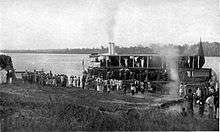
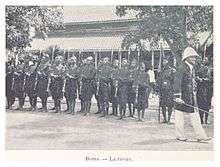
Leopold could not meet the costs of running the Congo Free State. Desperately, he set in motion a system to maximize revenue. The first change was the introduction of the concept of terres vacantes, "vacant" land, which was any land that did not contain a habitation or a cultivated garden plot. All of this land (i.e., most of the country) was therefore deemed to belong to the state. Servants of the state (namely any men in Leopold's employ) were encouraged to exploit it.
Shortly after the anti-slavery conference he held in Brussels in 1889, Leopold issued a new decree which said that Africans could only sell their harvested products (mostly ivory and rubber) to the state in a large part of the Free State. This law grew out of the earlier decree which had said that all "unoccupied" land belonged to the state. Any ivory or rubber collected from the state-owned land, the reasoning went, must belong to the state. Suddenly, the only outlet a large share of the local population had for their products was the state, which could set purchase prices and therefore could control the amount of income the Congolese could receive for their work. However, for local elites this system presented new opportunities as the Free State and concession companies paid them with guns to tax their subjects in kind.
Trading companies began to lose out to the free state government, which not only paid no taxes but also collected all the potential income. These companies were outraged by the restrictions on free trade, which the Berlin Act had so carefully protected years before.[21] Their protests against the violation of free trade prompted Leopold to take another, less obvious tack to make money.
A decree in 1892 divided the terres vacantes into a domainal system, which privatized extraction rights over rubber for the state in certain private domains, allowing Leopold to grant vast concessions to private companies. In other areas, private companies could continue to trade but were highly restricted and taxed. The domainal system enforced an in-kind tax on the Free State's Congolese subjects. As essential intermediaries, local rulers forced their men, women and children to collect rubber, ivory and foodstuffs. Depending on the power of local rulers, the Free State paid below rising market prices.[22] In October 1892, Leopold granted concessions to a number of companies. Each company was given a large amount of land in the Congo Free State on which to collect rubber and ivory for sale in Europe. These companies were allowed to detain Africans who did not work hard enough, to police their vast areas as they saw fit and to take all the products of the forest for themselves. In return for their concessions, these companies paid an annual dividend to the Free State. At the height of the rubber boom, from 1901 until 1906, these dividends also filled the royal coffers.[23]
The Free Trade Zone in the Congo was open to entrepreneurs of any European nation, who were allowed to buy 10- and 15-year monopoly leases on anything of value: ivory from a district or the rubber concession, for example. The other zone—almost two-thirds of the Congo—became the Domaine Privé, the exclusive private property of the state.
In 1893, Leopold excised the most readily accessible 259,000 km2 (100,000 sq mi) portion of the Free Trade Zone and declared it to be the Domaine de la Couronne, literally, "fief of the crown". Rubber revenue went directly to Leopold who paid the Free State for the high costs of exploitation.[24] The same rules applied as in the Domaine Privé.[19] In 1896 global demand for rubber soared. From that year onwards, the Congolese rubber sector started to generated vast sums of money at an immense cost for the local population.[25]
Scramble for Katanga

Early in Leopold's rule, the second problem—the British South Africa Company's expansionism into the southern Congo Basin—was addressed. The distant Yeke Kingdom, in Katanga on the upper Lualaba River, had signed no treaties, was known to be rich in copper and thought to have much gold from its slave-trading activities. Its powerful mwami (big chief), Msiri, had already rejected a treaty brought by Alfred Sharpe on behalf of Rhodes. In 1891 a Free State expedition extracted a letter from Msiri agreeing to their agents coming to Katanga and later that year Leopold sent the well-armed Stairs Expedition, led by William Grant Stairs, to take possession of Katanga one way or another.[26]
Msiri tried to play the Free State off against Rhodes and when negotiations bogged down, Stairs flew the Free State flag anyway and gave Msiri an ultimatum. Instead, Msiri decamped to another stockade. Stairs sent a force to capture him but he stood his ground, whereupon Captain Omer Bodson shot Msiri dead and was fatally wounded in the resulting fight.[26] The expedition cut off Msiri's head and put it on a pole, as he had often done to his enemies. This was to impress upon the locals that his rule was really ended, after which the successor chief recognized by Stairs signed the treaty.[27]
War with Arab slavers
In the short term, the third problem, that of the African slavers like Zanzibari/Swahili strongman Tippu Tip was solved. Leopold negotiated an alliance and later appointed Tip as governor of the Stanley Falls District. In the longer term this was unsatisfactory. At home Leopold found it embarrassing to be allied with Tip because of anti-slavery sentiment. Even worse, Tip and Leopold were commercial rivals. Every person that Tippu Tip extracted from his realm into chattel slavery and every pound of ivory, was a loss to Leopold. This, and Leopold's humanitarian pledges to the Berlin Conference to end slavery, meant war was inevitable.
Both sides fought by proxy, arming and leading the populations of the upper Congo forests in a conflict. By early 1894 the war was over.
Economy during Leopold's rule
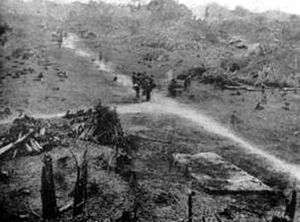
While the war against African powers was ending, the quest for income was increasing, fueled by the aire policy. By 1890, Leopold was facing considerable financial difficulty. District officials' salaries were reduced to a bare minimum, and made up with a commission payment based on the profit that their area returned to Leopold. After widespread criticism, this "primes system" was substituted for the allocation de retraite in which a large part of the payment was granted, at the end of the service, only to those territorial agents and magistrates whose conduct was judged "satisfactory" by their superiors. This meant in practice that nothing changed. Congolese communities in the Domaine Privé were not merely forbidden by law to sell items to anyone but the state; they were required to provide state officials with set quotas of rubber and ivory at a fixed, government-mandated price and to provide food to the local post.[28]
In direct violation of his promises of free trade within the CFS under the terms of the Berlin Treaty, not only had the state become a commercial entity directly or indirectly trading within its dominion, but also, Leopold had been slowly monopolizing a considerable amount of the ivory and rubber trade by imposing export duties on the resources traded by other merchants within the CFS. In terms of infrastructure, Leopold's regime began construction of the railway that ran from the coast to the capital of Leopoldville (now Kinshasa). This project, known today as the Matadi–Kinshasa Railway, took years to complete.

By the final decade of the 19th century, John Boyd Dunlop’s 1887 invention of inflatable, rubber bicycle tubes and the growing popularity of the automobile dramatically increased global demand for rubber. To monopolize the resources of the entire Congo Free State, Leopold issued three decrees in 1891 and 1892 that reduced the native population to serfs. Collectively, these forced the natives to deliver all ivory and rubber, harvested or found, to state officers thus nearly completing Leopold's monopoly of the ivory and rubber trade. The rubber came from wild vines in the jungle, unlike the rubber from Brazil (Hevea brasiliensis), which was tapped from trees. To extract the rubber, instead of tapping the vines, the Congolese workers would slash them and lather their bodies with the rubber latex. When the latex hardened, it would be scraped off the skin in a painful manner, as it took off the worker's hair with it.[29]
The Force Publique (FP), Leopold's private army, was used to enforce the rubber quotas. Early on, the FP was used primarily to campaign against the Arab slave trade in the Upper Congo, protect Leopold's economic interests, and suppress the frequent uprisings within the state. The Force Publique's officer corps included only white Europeans (Belgian regular soldiers and mercenaries from other countries). On arriving in the Congo, these recruited men from Zanzibar and west Africa, and eventually from the Congo itself. In addition, Leopold had been actually encouraging the slave trade among Arabs in the Upper Congo in return for slaves to fill the ranks of the FP. During the 1890s, the FP's primary role was to exploit the natives as corvée laborers to promote the rubber trade.
Many of the black soldiers were from far-off peoples of the Upper Congo, while others had been kidnapped in raids on villages in their childhood and brought to Roman Catholic missions, where they received a military training in conditions close to slavery. Armed with modern weapons and the chicotte—a bull whip made of hippopotamus hide—the Force Publique routinely took and tortured hostages, slaughtered families of rebels, and flogged and raped Congolese people. They also burned recalcitrant villages, and above all, cut off the hands of Congolese natives, including children. The human hands were collected as trophies on the orders of their officers to show that bullets hadn't been wasted. Officers were concerned that their subordinates might waste their ammunition on hunting animals for sport, so they required soldiers to submit one hand for every bullet spent.[30] These mutilations also served to further terrorize the Congolese into submission. This was all contrary to the promises of uplift made at the Berlin Conference which haf recognized the Congo Free State.
Humanitarian disaster
Mutilation

Failure to meet the rubber collection quotas was punishable by death. Meanwhile, the Force Publique were required to provide the hand of their victims as proof when they had shot and killed someone, as it was believed that they would otherwise use the munitions (imported from Europe at considerable cost) for hunting.[30] As a consequence, the rubber quotas were in part paid off in chopped-off hands. Sometimes the hands were collected by the soldiers of the Force Publique, sometimes by the villages themselves. There were even small wars where villages attacked neighboring villages to gather hands, since their rubber quotas were too unrealistic to fill. A Catholic priest quotes a man, Tswambe, speaking of the hated state official Léon Fiévez, who ran a district along the river 500 kilometres (300 mi) north of Stanley Pool:
All blacks saw this man as the devil of the Equator...From all the bodies killed in the field, you had to cut off the hands. He wanted to see the number of hands cut off by each soldier, who had to bring them in baskets...A village which refused to provide rubber would be completely swept clean. As a young man, I saw [Fiévez's] soldier Molili, then guarding the village of Boyeka, take a net, put ten arrested natives in it, attach big stones to the net, and make it tumble into the river...Rubber causes these torments; that's why we no longer want to hear its name spoken. Soldiers made young men kill or rape their own mothers and sisters.[31]
One junior European officer described a raid to punish a village that had protested. The European officer in command "ordered us to cut off the heads of the men and hang them on the village palisades ... and to hang the women and the children on the palisade in the form of a cross."[32] After seeing a Congolese person killed for the first time, a Danish missionary wrote, "The soldier said 'Don't take this to heart so much. They kill us if we don't bring the rubber. The Commissioner has promised us if we have plenty of hands he will shorten our service.'"[33] In Forbath's words:
The baskets of severed hands, set down at the feet of the European post commanders, became the symbol of the Congo Free State. ... The collection of hands became an end in itself. Force Publique soldiers brought them to the stations in place of rubber; they even went out to harvest them instead of rubber... They became a sort of currency. They came to be used to make up for shortfalls in rubber quotas, to replace... the people who were demanded for the forced labour gangs; and the Force Publique soldiers were paid their bonuses on the basis of how many hands they collected.
In theory, each right hand proved a killing. In practice, soldiers sometimes "cheated" by simply cutting off the hand and leaving the victim to live or die. More than a few survivors later said that they had lived through a massacre by acting dead, not moving even when their hands were severed, and waiting till the soldiers left before seeking help. In some instances a soldier could shorten his service term by bringing more hands than the other soldiers, which led to widespread mutilations and dismemberment.
Death toll
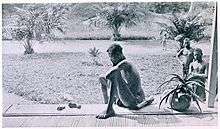
A reduction of the population of the Congo is noted by all who have compared the country at the beginning of Leopold's control with the beginning of Belgian state rule in 1908, but estimates of the death toll vary considerably. Estimates of contemporary observers suggest that the population decreased by half during this period and these are supported by some modern scholars such as Jan Vansina.[35] Others dispute this. Scholars at the Royal Museum for Central Africa argue a decrease of 15 percent over the first forty years of colonial rule (up to the census of 1924).
According to British diplomat Roger Casement, this depopulation had four main causes: "indiscriminate war", starvation, reduction of births, and disease.[36] Sleeping sickness was also a major cause of fatality at the time. Opponents of Leopold's rule stated, however, that the administration itself was to be considered responsible for the spreading of the epidemic.[37]
In the absence of a census providing even an initial idea of the size of population of the region at the inception of the Congo Free State (the first was taken in 1924),[38] it is impossible to quantify population changes in the period. Despite this, Forbath claimed the loss was at least five million[39] Adam Hochschild, and Isidore Ndaywel è Nziem, 10 million;[40][41] However, no verifiable records exist. Louis and Stengers state that population figures at the start of Leopold's control are only "wild guesses", while calling E.D. Morel's attempt and others at coming to a figure for population losses "but figments of the imagination".[42]
Nevertheless, Hochschild cites several recent independent lines of investigation, by anthropologist Jan Vansina and others, that examine local sources (police records, religious records, oral traditions, genealogies, personal diaries), which generally agree with the assessment of the 1919 Belgian government commission: roughly half the population perished during the Free State period. Since the first official census by the Belgian authorities in 1924 put the population at about 10 million, these various approaches suggest a rough estimate of a total of 10 million dead.[43] To put these population changes in context, sourced references state that in 1900 Africa as a whole had between 90 million[44] and 133 million people.[45]
International criticism
Leopold ran up high debts with his Congo investments before the beginning of the worldwide rubber boom in the 1890s. Prices increased throughout the decade as industries discovered new uses for rubber in tires, hoses, tubing, insulation for telegraph and telephone cables and wiring. By the late-1890s, wild rubber had far surpassed ivory as the main source of revenue from the Congo Free State. The peak year was 1903, with rubber fetching the highest price and concessionary companies raking in the highest profits.
However, the boom sparked efforts to find lower-cost producers. Congolese concessionary companies started facing competition from rubber cultivation in Southeast Asia and Latin America. As plantations were begun in other tropical areas—mostly under the ownership of the rival British firms—world rubber prices started to dip. Competition heightened the drive to exploit forced labour in the Congo in order to lower production costs. Meanwhile, the cost of enforcement was eating away at profit margins, along with the toll taken by the increasingly unsustainable harvesting methods. As competition from other areas of rubber cultivation mounted, Leopold's private rule was left increasingly vulnerable to international scrutiny.
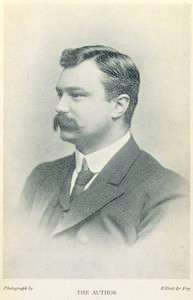
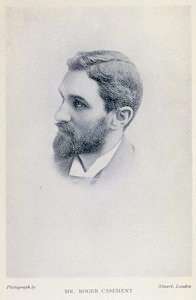
Missionaries were allowed only on sufferance, and Leopold was able to silence the Belgian Catholics. Rumours circulated so Leopold attempted to discredit them, even creating a Commission for the Protection of the Natives. Publishers were bribed, critics accused of running secret campaigns to further other nations' colonial ambitions, and eyewitness reports from missionaries such as William Henry Sheppard dismissed as attempts by Protestants to smear Catholic priests. For at least a decade, criticism was largely contained.
Congo Reform Association
Joseph Conrad’s Heart of Darkness, originally published in 1899 as a three-part series in Blackwood's Magazine, based on a brief experience as a steamer captain on the Congo 12 years before, sparked an organized international opposition to Leopold's genocidal activities, which mobilized. In 1900, Edmund Dene Morel, a part-time journalist and head of trade with Congo for the Liverpool shipping firm Elder Dempster, noticed that ships that brought vast loads of rubber from the Congo only ever returned there loaded with guns and ammunition for the Force Publique. Morel became a journalist and then a publisher, attempting to discredit Leopold's regime. In 1902, Morel retired from his position at Elder Dempster to focus on campaigning. He founded his own magazine, The West African Mail, and conducted speaking tours in Britain.
Increasing public outcry over the atrocities in the CFS moved the British government to launch an official investigation. In 1903, Morel and those who agreed with him in the House of Commons succeeded in passing a resolution calling on the British government to conduct an inquiry into alleged violations of the Berlin Agreement. Roger Casement, then the British Consul at Boma (at the mouth of the Congo River), was sent to the Congo Free State to investigate. Reporting back to the Foreign Office in 1900, Casement wrote
"The root of the evil lies in the fact that the government of the Congo is above all a commercial trust, that everything else is orientated towards commercial gain..."
The Congo Reform Association (CRA) was established in Great Britain by Morel as a direct result of Casement’s 1904 detailed, eyewitness Congo report, known as the Casement Report. The Congo Reform movement's members included Sir Arthur Conan Doyle, Mark Twain, Joseph Conrad, Booker T. Washington, and Bertrand Russell.
The mass deaths in the Congo Free State became a cause célèbre in the last years of the 19th century. The Congo reform movement led a vigorous international movement against the maltreatment of the Congolese population.[46][47] The British Parliament demanded a meeting of the 14 signatory powers to review the 1885 Berlin Agreement. The Belgian Parliament, pushed by Emile Vandervelde and other critics of the king's Congolese policy, forced Leopold to set up an independent commission of inquiry, and despite the king's efforts, in 1905 it confirmed Casement's report.
Annexation as Belgian Congo
Leopold offered to reform his regime, but international opinion supported an end to the king's rule, and no nation was willing to accept this responsibility. Belgium was the obvious European candidate to run the Congo. For two years, it debated the question and held new elections on the issue.
Yielding to international pressure, the parliament of Belgium annexed the Congo Free State and took over its administration on November 15, 1908, as the colony of the Belgian Congo. Despite being effectively removed from power, the international scrutiny was no major loss to Leopold or the concessionary companies in the Congo. By then Southeast Asia and Latin America had become lower-cost producers of rubber. Along with the effects of resource depletion in the Congo, international commodity prices had fallen to a level that rendered Congolese extraction unprofitable. Just prior to releasing sovereignty over the CFS, Leopold had all evidence of his activities in the CFS destroyed, including the archives of the departments of finance and of the interior. Leopold lost the absolute power he had had there, but the population still had a Belgian colonial regime, which had become heavily paternalistic, with church, state, and private companies all instructed to oversee the welfare of the inhabitants.[48]
Legacy
The Order of the Crown, originally created in 1897, rewarded heroic deeds and service achieved while serving in the Congo Free State. The Order was made a decoration of the Belgian state with the abolition of the Congo Free State in 1908 and is still awarded today.
Genocide question
In the aftermath of the publication of King Leopold's Ghost by Adam Hochschild, where he had written "the killing in the Congo was of genocidal proportions", but, however, "it was not strictly speaking a genocide",[49] The Guardian reported that the Royal Museum for Central Africa in Brussels would finance an investigation into some of the claims made by Hochschild. An investigatory panel announced in 2002, likely to be headed by Professor Jean-Luc Vellut, was scheduled to report its findings in 2004.[47] Robert G. Weisbord stated in the 2003 Journal of Genocide Research that attempting to eliminate a portion of the population is enough to qualify as genocide under the UN convention. In the case of the Congo Free State, the unbearable conditions would qualify as a genocide.[49]
In the aftermath of the report, an exhibition was held at the Royal Museum for Central Africa entitled The Memory of Congo. Critics, including Hochschild, claiming that there were "distortions and evasions" in the exhibition and stated "The exhibit deals with this question in a wall panel misleadingly headed 'Genocide in the Congo?' This is a red herring, for no reputable historian of the Congo has made charges of genocide; a forced labor system, although it may be equally deadly, is different."[4] An early day motion presented to the British Parliament in 2006 described "the tragedy of King Leopold's regime" as genocide and called for an apology from the Belgian government. It received the signature of 48 members of parliament.[50]
See also
- King Leopold's Ghost
- King Leopold's Soliloquy
- Lado Enclave
- Royal Museum for Central Africa
- List of colonial governors of the Congo Free State and Belgian Congo
- Anglo-Belgian India Rubber Company
References
- ↑ Encyclopædia Britannica
- 1 2 Gifford, Paul (1971). France and Britain in Africa. Imperial Rivalry and Colonial Rule. New Haven: Yale University Press. pp. 221–260. ISBN 9780300012897.
- ↑ Vansina, Jan (2010). "Being Colonized. The Kuba Experience in Rural Congo, 1880-1960". Madison.
- 1 2 Hochschild, Adam (October 6, 2005). "In the Heart of Darkness". The New York Review of Books. Retrieved July 15, 2014.
- ↑ Gann, L.H. (1979). The rulers of Belgian Africa, 1884-1914. New Jersey: Princeton University Press. ISBN 9780691631813.
- ↑ Encyclopaedia Britannica, Inc. (2011). World Exploration From Ancient Times. Encyclopaedia Britannica, Inc. p. 65. ISBN 9781615354559.
- ↑ Sir Henry Morton Stanley (1978). Through the Dark Continent. New York: Harper and Brothers – via Internet Archive.
- 1 2 3 New International Encyclopedia.
- ↑ René de Pont-Jest: L'Expédition du Katanga, d'après les notes de voyage du marquis Christian de Bonchamps Archived February 5, 2010, at the Wayback Machine. published 1892 in: Edouard Charton (editor): Le Tour du Monde magazine, website accessed 5 May 2007. Section I: "D'ailleurs ces lettres de soumission de ces petits tyrans africains, auxquels on lit quatre longues pages, dont, le plus souvent, ils ne comprennent pas un mot, et qu'ils approuvent d'une croix, afin d'avoir la, paix et des présents, ne sont sérieuses que pour les puissances européennes, en cas de contestations de territoires. Quant au souverain noir qui les signe, il ne s'en inquiète pas un seul instant."
- ↑ Adam Hochschild, King Leopold's Ghost (1999), p. 58.
- ↑ Ascherson 1999, p. 136.
- ↑ Pakenham 1992, pp. 12–5.
- ↑ Pakenham 1992, pp. 253–5.
- ↑ Hochschild 1998, 81
- 1 2 3 Lewis H. Gann and Peter Duignan (1979), The Rulers of Belgian Africa, 1884–1914 (Princeton, NJ: Princeton University Press), 86–91.
- ↑ Gann and Duignan (1979), 94–95.
- ↑ De Roo, Bas (2014). "The blurred lines of legality. Customs and contraband in the Congolese M'Bomu Region (1889-1908)". Journal of Belgian History. XLIV (4).
- ↑ David Northrup. Beyond the Bend in the River. African Labor in Eastern Zaïre, 1865-1940 (Athens: Ohio University Press, 1988).
- 1 2 Stengers, Jean (1985). "King Leopold's Congo 1886-1908". The Cambridge History of Africa. 6.
- ↑ Joseph Moloney: With Captain Stairs to Katanga. Sampson Low, Marston & Co, London (1893), p11.
- ↑ De Roo, Bas (2015). "The Trouble with Tariffs: Customs Policies and the Shaky Balance between Colonial and Private Interests in the Congo (1886-1914)". Low Countries Journal of Social and Economic History. 10 (2).
- ↑ Vos, J. (2008). The Economics of the Kwango rubber trade c.1900. Angola on the Move: Transport Routes, Communications and History. B. Heintze and A. von Oppen. Frankfurt am Main, Lembeck: 85-98.
- ↑ Frankema, Ewout (2013). Colonial Exploitation and Economic Development. The Belgian Congo and the Netherlands Indies Compared. London: Routledge. ISBN 9780415521741.
- ↑ Jean Stengers. "Combien le Congo à-t-il coûté à la Belgique." Bruxelles: Academie Royale des Sciences Coloniale 1957.
- ↑ Harms, Robert (1975). "The end of red rubber: a reassessment". The Journal of African History. 16 (1).
- 1 2 Moloney (1893): Chapter X–XI.
- ↑ René de Pont-Jest: L'Expédition du Katanga, d'après les notes de voyage du marquis Christian de Bonchamps Archived February 5, 2010, at the Wayback Machine. published 1892 in: Edouard Charton (editor): Le Tour du Monde magazine, website accessed 5 May 2007.
- ↑ Hochschild, Adam (1999). King Leopold's Ghost. Mariner Books. pp. 161–162, 229–230.
- ↑ Hochschild, Adam. King Leopold's Ghost: A Story of Greed, Terror, and Heroism in Colonial Africa. Boston and New York: Houghton Mifflin, 1998, 161.
- 1 2 Cawthorne, Nigel. The World's Worst Atrocities, 1999. Octopus Publishing Group. ISBN 0-7537-0090-5.
- ↑ Hochschild, King Leopold's Ghost, 166
- ↑ Bourne, Henry Richard Fox (1903). Civilisation in Congoland: A Story of International Wrong-doing. London: P. S. King & Son. p. 253. Retrieved 2007-09-26.
- ↑ Forbath, Peter (1977). The River Congo: The Discovery, Exploration and Exploitation of the World's Most Dramatic Rivers. Harper & Row. p. 374. ISBN 0-06-122490-1.
- ↑ E. D Morel, King Leopold's rule in Africa, pages 144-145
- ↑ Hochschild p.232–233.
- ↑ Hochschild p.226–232.
- ↑ Hochschild p.230–231.
- ↑ Shelton, Dinah (2005). Encyclopedia of Genocide and Crimes Against Humanity. Detroit, Michigan: Macmillan. p. 621. ISBN 0-02-865849-3.
- ↑ Forbath, Peter. The River Congo: The Discovery, Exploration, and Exploitation of the World's Most Dramatic River, 1991 (Paperback). Harper & Row. ISBN 0-06-122490-1.
- ↑ Hochschild.
- ↑ Isidore Ndaywel è Nziem. Histoire générale du Congo: De l'héritage ancien à la République Démocratique.
- ↑ Wm. Roger Louis and Jean Stengers: E.D. Morel's History of the Congo Reform Movement p.252-7
- ↑ Hochschild, Adam (2006). King Leopold's Ghost: A Story of Greed, Terror, and Heroism in Colonial Africa. pp. 225–33. ISBN 978-1-74329-160-3.
- ↑ Martin, Guy (2006). "What Went Wrong with Africa?". Review. African Studies Review. 49 (1): 179–181. doi:10.1353/arw.2006.0081.
- ↑ World Population Prospects: The 2006 Revision
- ↑ R. J. Rummel Exemplifying the Horror of European Colonization:Leopold's Congo"
- 1 2 Andrew Osborn. "Belgium exhumes its colonial demons". The Guardian, July 13, 2002.
- ↑ Manning, Patrick, The African Diaspora, pg. 227.
- 1 2 Weisbord, Robert G. (2003). "The King, the Cardinal and the Pope: Leopold II's genocide in the Congo and the Vatican". Journal of Genocide Research. 5: 35–45. doi:10.1080/14623520305651.
- ↑ http://www.parliament.uk/edm/2005-06/2251
Notes
-
 This article incorporates text from a publication now in the public domain: Gilman, D. C.; Thurston, H. T.; Colby, F. M., eds. (1905). "article name needed". New International Encyclopedia (1st ed.). New York: Dodd, Mead.
This article incorporates text from a publication now in the public domain: Gilman, D. C.; Thurston, H. T.; Colby, F. M., eds. (1905). "article name needed". New International Encyclopedia (1st ed.). New York: Dodd, Mead. - Forbath, Peter, The River Congo, 1977. Harper & Row. ISBN 0-06-122490-1
- Hochschild, Adam, King Leopold's Ghost, Pan (1999). ISBN 0-330-49233-0.
Further reading
- Ascherson, Neal, The King Incorporated, ISBN 1-86207-290-6, 1963.
- Grant, Kevin, A Civilised Savagery: Britain and the New Slaveries in Africa, 1884–1926, Routledge (London, 2005). ISBN 0-415-94901-7
- Johnston, George Grenfell and the Congo (two volumes, London, 1908).
- Morel, E. D. (Edmund Dene), 1873–1924, E. D. Morel's history of the Congo reform movement; [edited by] Wm. Roger Louis and Jean Stengers, Oxford, Clarendon Press, 1968 (includes Morel and the Congo Reform Association, 1904–1913, by W. R. Louis and Morel and Belgium, by J. Stengers).
- Ó Síocháin, Séamas: Roger Casement: Imperialist, Rebel, Revolutionary. Dublin: Lilliput Press, 2008.
- Pakenham, Thomas, The scramble for Africa, Abacus. (1991) ISBN 0-349-10449-2.
- Petringa, Maria, Brazza, A Life for Africa, AuthorHouse. (2006) ISBN 978-1-4259-1198-0
- Rodney, Walter, How Europe underdeveloped Africa, Howard University Press. (1974) ISBN 0-88258-013-2
- Roes, Aldwin (2010). "Towards a History of Mass Violence in the Etat Indépendant du Congo, 1885-1908". South African Historical Journal. 62 (4): 634–70. doi:10.1080/02582473.2010.519937.
- Stanard, Matthew G. Selling the Congo: A history of European pro-empire propaganda and the making of Belgian imperialism (U of Nebraska Press, 2012)
- Vandersmissen, Jan, The king's most eloquent campaigner... Emile de Laveleye, Leopold II and the creation of the Congo Free State, in: Belgisch tijdschrift voor nieuwste geschiedenis, 2011, blz. 7-57.
- Guy Vanthemsche (2012). Belgium and the Congo, 1885-1980. Cambridge University Press.
- Wesseling, H. L.; Pomerans, Arnold J. (1996). Divide and Rule: The Partition of Africa, 1880–1914. Westport, Connecticut: Praeger Publishing. ISBN 0-275-95137-5..
Primary sources
- Ó Síocháin, Séamas and Michael O’Sullivan, eds: The Eyes of Another Race: Roger Casement's Congo Report and 1903 Diary. University College Dublin Press, 2004. ISBN 1-900621-99-1.
- Stanley, The Congo and the Founding of the Congo Free State (London, 1885)
- Report of the British Consul, Roger Casement, on the Administration of the Congo Free State, reprinted in full in The eyes of another race: Roger Casement’s Congo report and 1903 diary edited by Seamas O Siochain and Michael O’Sullivan. Dublin, 2003.
- The reports of the Congo Reform Association, particularly the "Memorial on the Present Phase of the Congo Question" (London, 1912).
- The Congo Report of Commission of Inquiry (New York, 1906)
External links
| Wikimedia Commons has media related to Congo Free State. |
- Heart of Darkness, the novel
- The Crime of the Congo, by Sir Arthur Conan Doyle at Google Books
- A Journal of a Tour in the Congo Free State, 1905, by Marcus Dorman, from Project Gutenberg
- Catalogue of the Edmund Morel papers at the Archives Division of the London School of Economics.
- "Congo Free State", 1911 Britannica article, 1911Encyclopedia.org
